Many years ago, before I published Hot Yoga MasterClass, I received a question from one of my many subscribers. It highlights a problem that almost every Bikram student or hot yogi experiences in their practice in public studios around the world. Unfortunately, there is a very important physiological condition that following the dialog actually causes in the vast majority of students.
So, if you’ve ever …
- had a lower back ache,
- if you’ve ever felt tightness in your hamstrings,
- if you’ve ever been unable to keep your back straight in a forward bend (and your back or legs have hurt while bending over)
- if you’ve ever been told to straighten your legs and lock them in order to find extra length in your hamstrings, and you’ve maybe even had this problem for a while and the yoga isn’t fixing it…then really need to read this blog post and follow its advice to the letter. Hundreds of my forum customers (that I know about, and thousands that have read this blog) have benefitted from applying sound physiological principles to their yoga practice. What you want is pain-free practice. Here’s one huge way of how to get it!
As you can see from the incomplete list above that there are lots of warning signs. Being unable to straighten your back in a forward bend is often a clear indication of a hamstring problem.
There are often other related tight areas in the body. For example, being unable to bend forward with a straight back, or even if you have a tendency towards rounded shoulders, could also include as its cause, tightness of the broad muscle sheets called latissimus dorsi – or commonly called your lats.
Other questions you can ask yourself when trying to ascertain where the cause lies are these: When you bring your arms over your head and clamp them in do your shoulders rise up or can you lengthen your neck and lock out your arms? Does your neck feel tight or chin drop?
There are specific techniques for stretching hamstrings with yoga, but these are often mis-directed in the classic hot yoga sequence. It is knowing specifically how to use these concepts that can escape us. I will try to help you determine whether your poses can be approached in maybe a better way. And give you some ideas to stretch your muscles using the heat (after a yoga class) or at home.
Reciprocal inhibition is one way our muscles work: one muscle works hard and the opposing one relaxes. Unfortunately, while this concept seems rather easy to grasp (ie, one muscle or muscle group contracts and the opposing ones relax) it is with misguided application of this idea in the yoga room that can actually damage, strain or tear your hamstrings.
You see, if you’ve got your bottom on the floor and you contract your quadriceps muscles on the front of your leg, then this concept holds true: Your hamstrings will relax. However, what most teachers fail to understand is that when you are standing, that you do not get black and white contraction of quadriceps and relaxation of hamstrings because something else is going on here.
Yep, that’s right. When you’re standing, there are certain postural muscles that keep ‘firing’. So even though you contract your quads, you’ll always have a significant proportion of your hamstrings contracting, because quite simply, this interplay of muscles, front and back of leg, are allowing you to stay standing.
This misunderstanding means that many poses are being taught via the script, completely ignoring the implications of straight-leg biomechanics.
There are a several poses in the series where straight legs are ‘demanded’ by the script, but actually the outcome of the pose combined with YOUR own flexibility and capabilities means that you must understand the physiological need to make the choice of having EITHER bent OR straight legs. The standing poses of this type, where the choice is crucial, are:
- Hands To Feet Pose, (Padahastasana)
- Standing Intense Stretching Pose (Dandayamana Bibhaktapada Paschimottanasana).
Now, we ALL know that in Padahastasana, the script demands you to keep your body on your thighs the whole time. Yet, very confusingly, you are told to ‘straighten the legs’ and ‘lock the legs’ again, and again and again, even if your legs can only open up to a 120 degree angle (nowhere near a straight 180 degrees).
To be honest, I find it extremely annoying that despite having a class full of people who are in no way close to locking out their straight legs, that teachers who don’t understand this important physiological need to bend the legs while stretching, scream out to lock the legs, when not even one person is close to doing so.
To throw a physiological spanner in our understanding there is another reflex to add to Reciprocal Inhibition to complicate the issue (or add some clarity – hahaha). When you use your arms properly in these poses a reflex called the clasped knife reflex is activated. When you pull hard, with your biceps, so that your elbows point backward (and never out to the sides) then your hamstrings reflexively relax – even when your legs are bent.
With Hands2Feet you already know to keep your body on your legs. If you have even a little space between body and legs, then you start to use your arms in a different way. Your shoulders erroneously get engaged and the result is LESS STRETCH through the back of the body.
Now, let’s look at Separate Leg Intense Stretch pose. If you examine what’s happening in this pose you’ll discover it’s almost identical to Hands2Feet pose. The only real difference is that your legs are apart instead of being together. Just like Padahastasana, you must engage your biceps to pull. When you do, the shoulders move away from the head, decompressing the neck, recruiting more power, and at the same time resolving tension.
Now that sounds pretty simple but you need to make sure of a couple of other details. The instructions in most studios are to step out 4 foot. But did you know you can have your feet too far apart for your body? 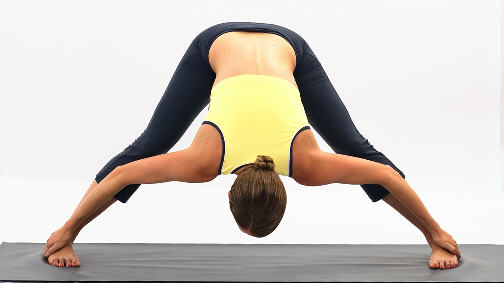
This photo shows Lauren is stepping out too wide
The photo above is of a friend of mine, Lauren who practises yoga in another city. She wasn’t getting anywhere with this pose so I asked her to do it for me the way she has been taught. This is REALLY how this happened, honest! When you step out too far your grip is compromised. When my husband started Hot Yoga years ago, he was stepping out too far and causing spasms in his abductor muscles. So you can acknowledge that the command to ‘step out further if your forehead doesn’t touch the floor’ doesn’t apply to everyone.
Anyway, I digress. What Lauren was doing was following (recited script) directions. Her step out was as commanded but then she could only reach the sides of her feet. And she was only able to slip her fingers in under her arches at a 90 degree angle. This is the least effective foot grip.
Ideally you want to be grabbing your feet from behind your heels. If you can’t manage that then aim to grip from the sides of your heels, and if that is difficult, grip as far to the back as possible and definitely behind the arch. Try bending your legs quite a bit more than usual to get the grip.
Then bend your elbows near your shins and pull with your biceps, trying to angle your elbows close to your legs. With your legs bent and the pull as described you begin to feel a lengthening stretch not only in your legs but also in your back. In other words, what you do by standing with your legs more closely together and BENDING your legs, creates more EASE in the back of your legs.
Again, what you are doing is finding the hidden length in your hamstrings when you BEND your legs. See below. The photo above is when Lauren is standing with her legs too wide and her grip is wrong, and halfway up the foot at the arch.
As soon as Lauren took a slightly less wide step (below), she could grab her feet more from the back where they should be. Her legs were a bit more bent but immediately she could feel the stretch really WORKING through the back of her body. She was able to find more length in her legs and the pose INSTANTLY became easier.
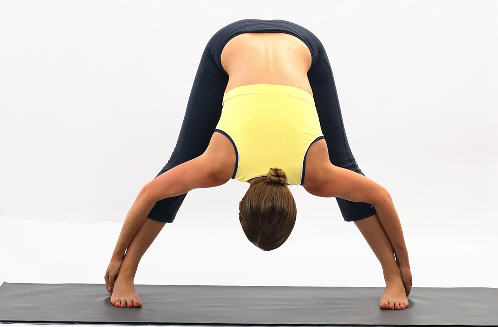
This photo shows Lauren doing it correctly
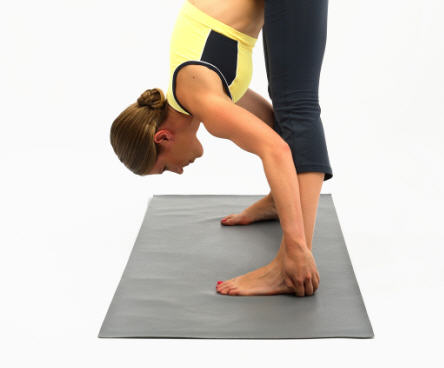
This photo shows the shorter (correct) step from the side
See the more effective stretch (above)? OK now look at the shoulder and hand positions in the photo with the shorter step out – notice the difference? This is the right way to do it!
Now see what happens (photo below) when Lauren steps out too far – this time from the side.
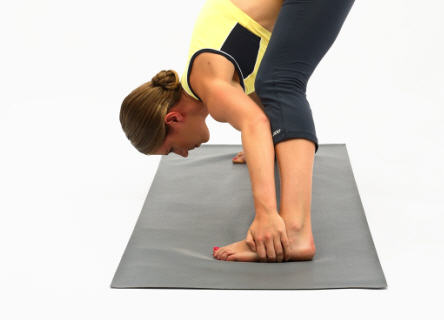
This photo shows Lauren stepping out too wide
The other issue is working out whether to keep your legs straight or bent. Mostly students straighten their legs before they are ready. In reality, most students should have their legs bent. Do you remember the stretch you get in Hands2Feet?
That is for most students a bent leg pose. But you still manage to get your delicious stretch through the legs. This other Stretch pose uses the same concepts. When you come down, arms out, bend your legs and slide your hands down the back of your calf muscles to reach around behind the heels. With every fiber of your being, work on straightening your back. With your pull, work your chest through your shoulders.
Try to feel an arch in your spine rather than a rounded element. ONLY when your back is straight can you even contemplate straightening your legs. Most students should practise this pose with bent legs.
There are other poses which require you to pull on your feet where you need to sacrifice the desire for straight legs and bend up the legs to pull with your biceps muscles. These include Pashimottanasana (near the end) and you can even use this principle in your sit-ups.
If you want to get some extra stretches then a great time to surrender into some deep stretches is after class when the body is already very warm and more receptive to stretches. Make them long and slow. When I mean long, I mean hold them for minutes at a time. Your body will open slowly. But more specifically your body recognizes the safety in the stretch after the stretch is about 20 seconds long and starts to release and open up.
On occasion I have taken 10 minute stretches in one position. Now that’s an experience that’s very interesting.
OK, my yoga peeps, you may need to read this blog post a few times to be able to faithfully apply this technique. It’s possibly one of the most important ones I can teach you because if it’s not done properly, or if you continue to follow the scripted directions without understanding the meaning of the instruction (which applies to different bodies differently!) then you could be causing damage or preventing hamstrings feeling as good as they should. But I promise you this, done properly and your practice and body will change and you’ll never look back! 🙂

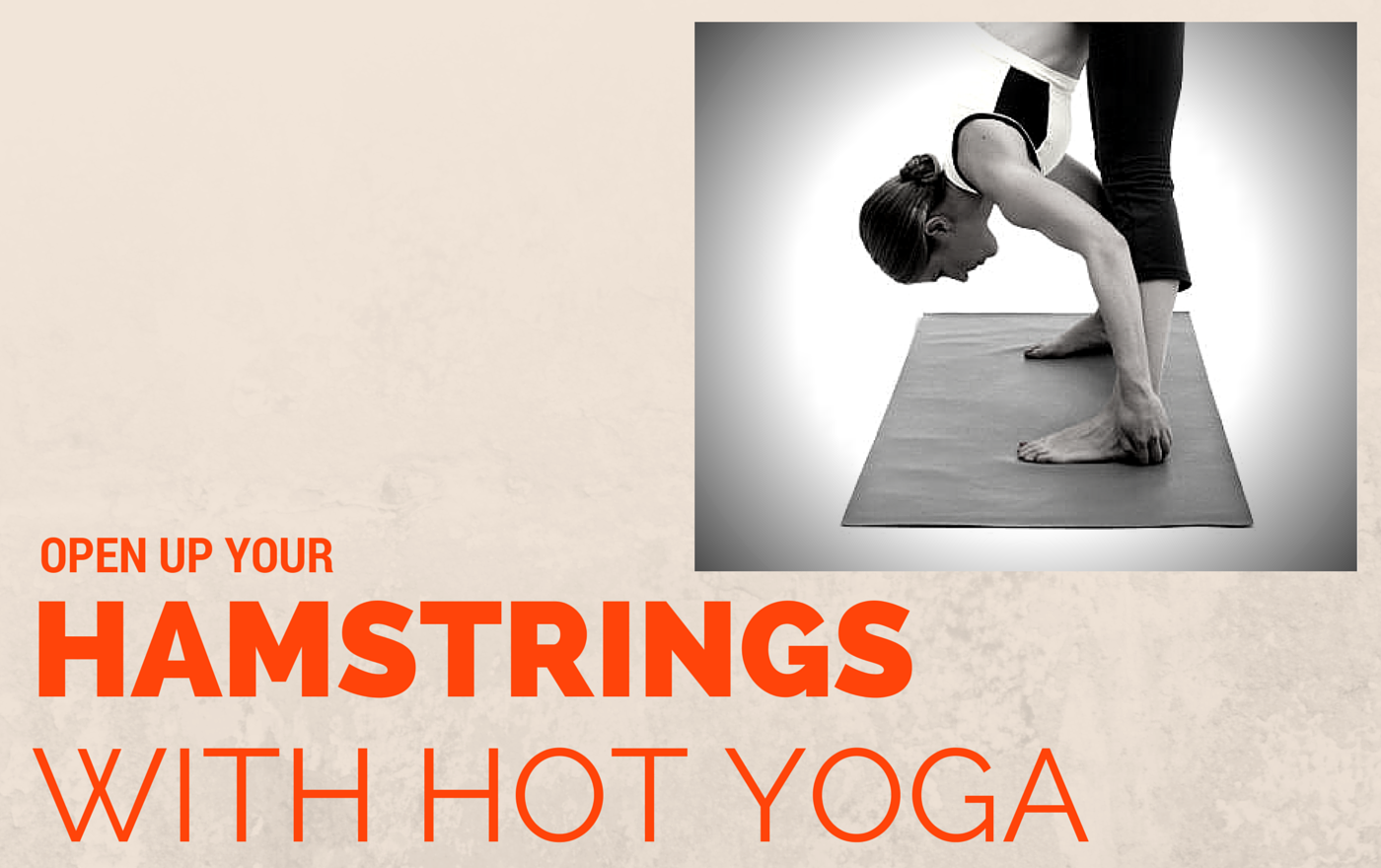
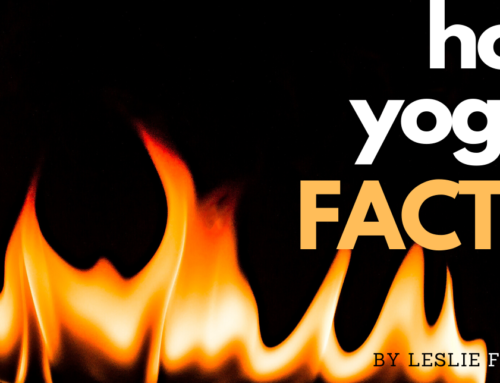


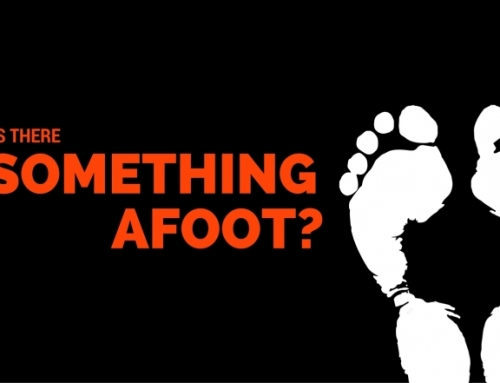
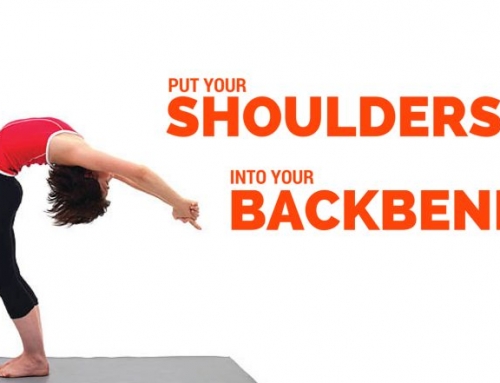
Thank you! Thank you! Thank you!
You’re welcome Joe!
Gabrielle,
If I still cannot hook my hands behind or beside my heels, even when I place my feet in a closer stance and bend my knees, should I then just place my hands on the floor?
Joe
Hi Joe
Do you manage to get your hands under your feet with bent legs for Hands2Feet Pose? And still keep bent legs? Then what I can suggest is to is start there and start moving your feet outward to the side. You may need to bend the legs more or less as you widen the stance. Your hands will shift slightly in angle. But if you can do that pose then you can 99,99999% of the time, do this one too.
Please tell me how you go
🙂
Hands2Feet (Padahastasana) has been the “bane of my existence” ever since I first set foot in a Bikram yoga studio in 2004. I cannot get my hands under my heels. The only good news is that I am slowly inching my fingertips, micrometer by micrometer, down in that direction.
Just to confirm: You are recommending I spread my feet apart in Hands2Feet (Padahastasana)? If so, I will try that tonight.
Actually not really! Think about those 2 poses. The first is a ‘legs together’ version of the second one. So if you’re able to do Hands to Feet, then theoretically you should be able to at least do a ‘legs apart’ version of Sep Leg Stretch by inching the feet outwards. Does that clarify it for you?
I do recommend larger folk, those with big breasts or tummies, or muscle bound folk who feel as though they’re toppling over, to put a small space between their feet in Hands to Feet pose. So there’s no need to put feet apart unless you fall into one of those groups that feels slightly unstable.
G
Thank you so much! This website is invaluable and targets the main problems people encounter when practicing bikram yoga
Is there a link somewhere to some hamstring stretches to practice after a class? My hamstrings which I never knew about have been singing painfully all the time since I started Bikram 4 months ago (5 times a week)
Thank you
Hi Tam, I am sending you an email in case you don’t check in to this post. You probably don’t need hamstrings stretches. You really need to apply the above technique diligently each and every time you do the intense stretch poses, padahastasana and the sit-ups. I hope the above corrects the key element that is being taught incorrectly and or being misinterpreted by the teacher and therefore by the students. Good luck!
G 🙂